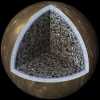Solar System -
Jupiter's Moons
Callisto
Callisto's composition is approximately 49% to 55% ices, with the rest as rock. It is thought to have formed over a period of up to 10 million years from the accretion disk that surrounded Jupiter. Because of its slow formation, and the lack of tidal heating, not enough heat was generated to melt the ice and allow Callisto to have a differentiated interior. The slow convection in the interior did permit some partial differentiation, so there may be an ocean beneath the crust as well as a small, rocky core, though the bulk of the interior is a mixture of rock and ices, with the density of the rock increasing with increasing depth. Once formed, Callisto evolved by the balance of the radioactive heating in the interior, cooling through thermal conduction near the surface, and convection in the interior. The convection effect is a very slow process, but extremely effective over timescales of hundreds of millions to billions of years.
While lacking any real mountains, there are two huge impact craters on Callisto. Valhalla is about 3,800 km across and Asgard is 1,600 km.
Spectroscopic analysis of the surface has revealed water ice, carbon dioxide, silicates, sulfur dioxide, and possibly ammonia, together with organic compounds. The lack of tidal heating means there has been little volcanism or plate tectonics, so the surface is very old, and shows evidence of heavy cratering. Unlike the other Galilean moons, Callisto's leading hemisphere (the one facing the direction of its orbit) is darker than the trailing hemisphere. The leading hemisphere appears high in sulfur dioxide, while the trailing one is high in carbon dioxide.
Callisto supports a very tenuous atmosphere of carbon dioxide and oxygen. The low gravity of Callisto means the atmosphere would be lost in a matter of days if it were not continually replenished by slow sublimation of carbon dioxide ice from the crust. While oxygen has yet to be detected in the atmosphere, the Hubble Space Telescope has found oxygen trapped within the surface.
Callisto orbits Jupiter at a distance of between 1,869,000 km and 1,897,000 km once every 16.689 days, which is also its rotational period. It is 4,820 km in diameter which is only about 60 km less than the planet Mercury, but because of its low density, it only weighs a little less than one third of Mercury's weight. Of the Jovian moons, only Ganymede is larger.
While lacking any real mountains, there are two huge impact craters on Callisto. Valhalla is about 3,800 km across and Asgard is 1,600 km.
Spectroscopic analysis of the surface has revealed water ice, carbon dioxide, silicates, sulfur dioxide, and possibly ammonia, together with organic compounds. The lack of tidal heating means there has been little volcanism or plate tectonics, so the surface is very old, and shows evidence of heavy cratering. Unlike the other Galilean moons, Callisto's leading hemisphere (the one facing the direction of its orbit) is darker than the trailing hemisphere. The leading hemisphere appears high in sulfur dioxide, while the trailing one is high in carbon dioxide.
Callisto supports a very tenuous atmosphere of carbon dioxide and oxygen. The low gravity of Callisto means the atmosphere would be lost in a matter of days if it were not continually replenished by slow sublimation of carbon dioxide ice from the crust. While oxygen has yet to be detected in the atmosphere, the Hubble Space Telescope has found oxygen trapped within the surface.
Callisto orbits Jupiter at a distance of between 1,869,000 km and 1,897,000 km once every 16.689 days, which is also its rotational period. It is 4,820 km in diameter which is only about 60 km less than the planet Mercury, but because of its low density, it only weighs a little less than one third of Mercury's weight. Of the Jovian moons, only Ganymede is larger.
Inner Moons • Io • Europa • Ganymede • Callisto • Himalia Group • Carme Group • Ananke Group • Pasiphae Group • Miscellaneous
Jupiter's moons are grouped as follows. Select to see details of the moon or the group of moons:


